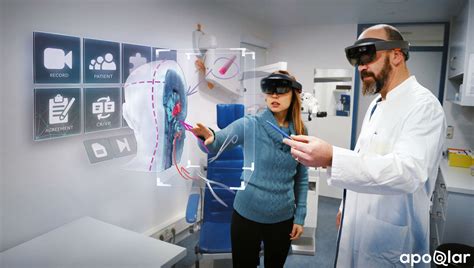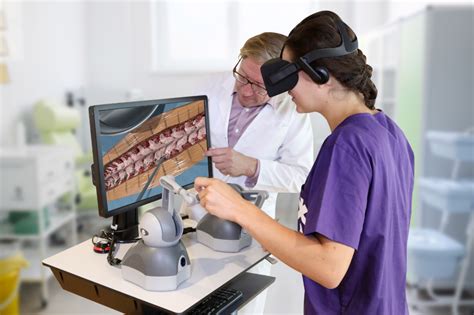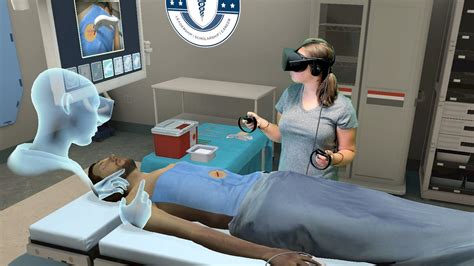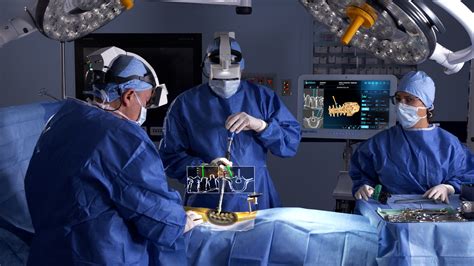Breaking News


Popular News


Explore the potential uses of augmented reality in surgery, including enhancing visualization, training, navigation, preoperative planning, and telemedicine applications.Augmented reality (AR) has been making waves in various industries, and its potential applications in the field of surgery are no exception. From enhancing surgical visualization and training to assisting in preoperative planning and navigation, AR technology holds promising possibilities for the advancement of surgical procedures. In this blog post, we will explore the various ways in which AR is poised to revolutionize the field of surgery, including its potential to improve surgical visualization, training, and navigation. We will also discuss the potential for AR to be used in telemedicine and remote surgery, offering new opportunities for delivering high-quality surgical care to patients in remote locations. Join us as we delve into the exciting possibilities of integrating AR technology into the world of surgery.
Contents

Augmented Reality (AR) technology has the potential to revolutionize the field of surgery by enhancing surgical visualization. With the use of AR, surgeons are able to overlay virtual images onto the real-world surgical environment, providing them with a better understanding of the patient’s anatomy and the surgical site. This allows for improved accuracy and precision during surgical procedures, ultimately leading to better patient outcomes.
One of the key benefits of using AR in surgical visualization is the ability to see through the patient’s body without making any incisions. This provides surgeons with a detailed view of the internal organs and structures, allowing them to plan and execute procedures with greater confidence. The use of AR can also help in minimizing the risk of damage to surrounding tissues and organs, leading to reduced complications and faster recovery times for patients.
Additionally, AR technology can be used to display real-time data and information during surgical procedures, such as vital signs, imaging results, and anatomical landmarks. This can help surgeons make more informed decisions, leading to improved surgical outcomes. Furthermore, AR can also be utilized to assist in the training of surgical residents and medical students, providing them with a more immersive and realistic learning experience.
Overall, the potential applications of AR in enhancing surgical visualization are vast, and as the technology continues to advance, we can expect to see even more innovative uses in the field of surgery. From improving accuracy and precision to providing a better training experience for aspiring surgeons, AR has the potential to significantly impact the future of surgical procedures.

Augmented Reality (AR) technology has the potential to revolutionize surgical training by providing realistic and immersive simulations for medical professionals. The use of AR simulations can enhance the traditional methods of surgical training, offering a more interactive and hands-on approach. Surgeons can now practice complex procedures in a safe and controlled virtual environment, allowing them to gain valuable experience and confidence before performing surgeries on real patients.
With AR simulations, trainees can visualize and interact with 3D models of anatomical structures, medical devices, and surgical instruments. This visual learning experience can improve their spatial awareness and depth perception, as well as their understanding of complex surgical techniques. By incorporating haptic feedback and realistic tissue simulations, AR simulations can also provide a tactile sensation that mimics the feel of performing a surgical procedure.
AR technology can be especially beneficial for training in minimally invasive surgeries, where the use of endoscopic cameras and specialized instruments requires a high level of technical skill and precision. By using AR simulations, trainees can practice navigating through virtual anatomical structures and performing delicate maneuvers with improved dexterity and precision, ultimately enhancing their surgical skills and reducing the learning curve for these advanced procedures.
In addition, AR simulations can also provide a collaborative learning environment, allowing trainees to work together in virtual operating rooms and learn from each other’s experiences. This interactive and team-based approach to surgical training can foster a sense of camaraderie among trainees and promote knowledge sharing, ultimately leading to a more comprehensive and effective training program.

Augmented Reality (AR) has the potential to revolutionize the way surgeons plan for operations. By utilizing AR technology, surgeons are able to visualize 3D models of a patient’s anatomy before the actual surgery takes place. This provides valuable insights and allows for a more accurate preoperative planning process.
One way AR can assist in preoperative planning is by providing a detailed and interactive view of the patient’s anatomy. Surgeons can use AR headsets or devices to overlay 3D images of the patient’s organs, bones, and other structures onto the real-world environment. This enables them to study the anatomy from multiple angles and identify any potential challenges or complications that may arise during the surgery.
In addition to visualizing the patient’s anatomy, AR can also enhance the preoperative planning process by allowing surgeons to simulate various surgical procedures. By using AR simulations, surgeons can practice different techniques and evaluate the best approach for the specific case. This can lead to improved surgical outcomes and reduced risk for the patient.

Augmented Reality (AR) has the potential to revolutionize the field of surgical navigation by providing surgeons with real-time, three-dimensional visual assistance during complex procedures. By overlaying digital information onto the surgeon’s field of view, AR technology can enhance the accuracy and precision of surgical navigation, ultimately leading to improved patient outcomes.
With AR, surgeons can benefit from enhanced spatial awareness and the ability to visualize critical anatomical structures, such as blood vessels and organs, in real time. This can be particularly valuable in minimally invasive surgeries, where visualization may be limited. By leveraging AR technology, surgeons can navigate complex anatomical structures more effectively, reducing the risk of inadvertent damage and improving overall surgical precision.
Furthermore, AR can also integrate patient-specific data, such as preoperative imaging scans, into the surgical navigation process. This allows surgeons to perform virtual preoperative planning and simulate the optimal approach for each individual patient, leading to more personalized and precise surgical navigation.
In addition to its intraoperative applications, AR technology can also support training and education for surgical navigation. By creating realistic AR simulations of surgical procedures, trainees can practice and refine their navigation skills in a safe and controlled environment. This not only enhances the training experience but also helps to standardize and improve the quality of surgical navigation across the field.

Augmented Reality (AR) has the potential to revolutionize the field of telemedicine and remote surgery. With AR technology, medical professionals can have access to real-time, interactive visual information that can assist them in making accurate diagnoses and performing complex surgical procedures, even from a distance.
One of the key advantages of AR in telemedicine is the ability to provide remote surgical guidance. Surgeons can use AR headsets to overlay digital images onto their field of view, allowing them to visualize the internal structures of the patient in real-time during a remote surgery. This can significantly improve the accuracy and precision of surgical procedures conducted from a remote location, ultimately leading to better patient outcomes.
Additionally, AR can be used to enhance the training of medical professionals in remote areas. By creating immersive AR simulations, trainees can practice surgical techniques and procedures in a realistic, virtual environment. This can help bridge the gap between the limited access to hands-on training in remote locations and the need for high-quality surgical education.
| Potential Applications of AR in Telemedicine and Remote Surgery |
|---|
| Enhancing Surgical Visualization |
| Improving Surgical Training |
| Assisting in Preoperative Planning |
| Enhancing Surgical Navigation |
In conclusion, the potential applications of AR in telemedicine and remote surgery are vast. From aiding in surgical visualization to improving training and assisting in preoperative planning, AR has the potential to reshape the way surgical procedures are conducted in remote and underserved areas. As the technology continues to advance, the possibilities for leveraging AR in telemedicine and remote surgery are endless.

What are the potential benefits of using augmented reality in surgery?
Some potential benefits of using augmented reality in surgery include improved accuracy, enhanced visualization of important structures, and better surgical planning.
How can augmented reality assist in preoperative planning for surgeons?
Augmented reality can assist in preoperative planning for surgeons by allowing them to visualize patient-specific anatomy and plan the surgery in a more precise manner.
What are some examples of surgical procedures that can benefit from augmented reality technology?
Surgical procedures such as orthopedic surgeries, neurosurgery, and laparoscopic procedures can benefit from augmented reality technology.
What challenges or limitations are associated with the use of augmented reality in surgery?
Challenges and limitations associated with the use of augmented reality in surgery include concerns about accuracy, the need for specialized training, and the cost of implementing the technology.
How does augmented reality enhance the training of future surgeons?
Augmented reality enhances the training of future surgeons by providing realistic simulation environments for practicing surgical procedures, allowing for better skill development and preparation for real-life surgeries.
Are there any regulatory or ethical considerations related to the use of augmented reality in surgery?
Regulatory and ethical considerations related to the use of augmented reality in surgery include patient safety, data privacy, and the need for proper validation and certification of the technology.
What does the future hold for the integration of augmented reality in the field of surgery?
The future holds great potential for the integration of augmented reality in the field of surgery, with ongoing advancements in technology, increasing acceptance by surgeons, and the development of more specialized applications.